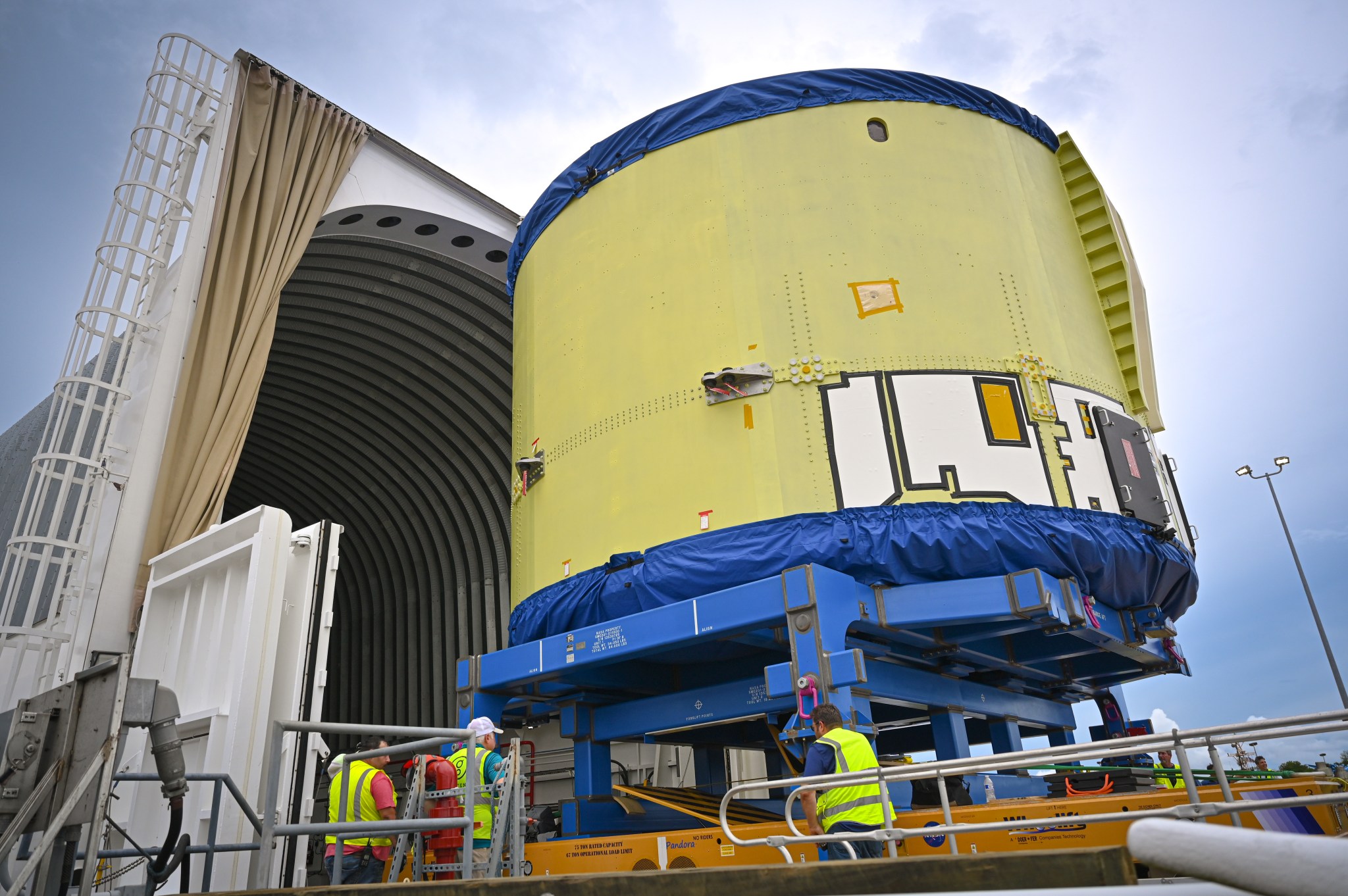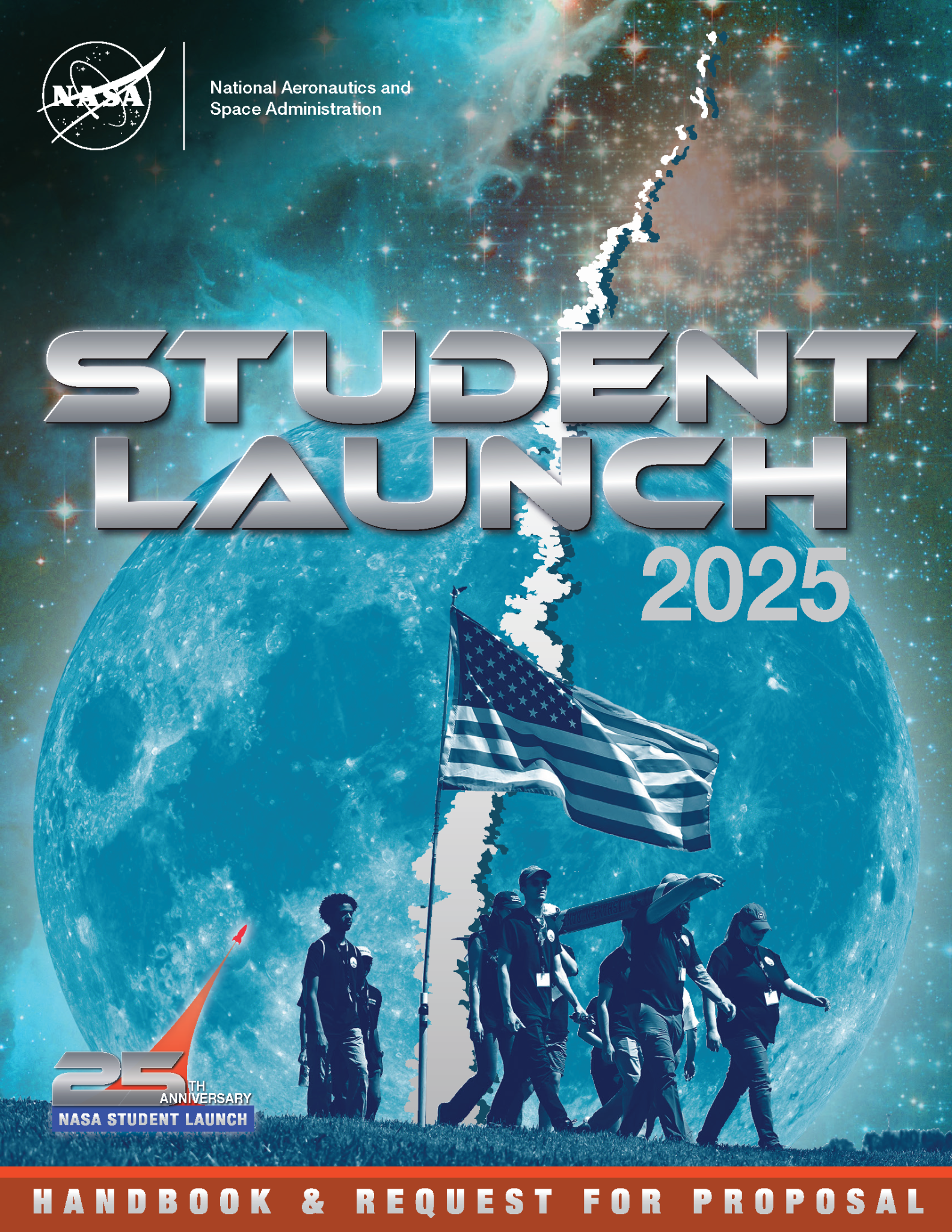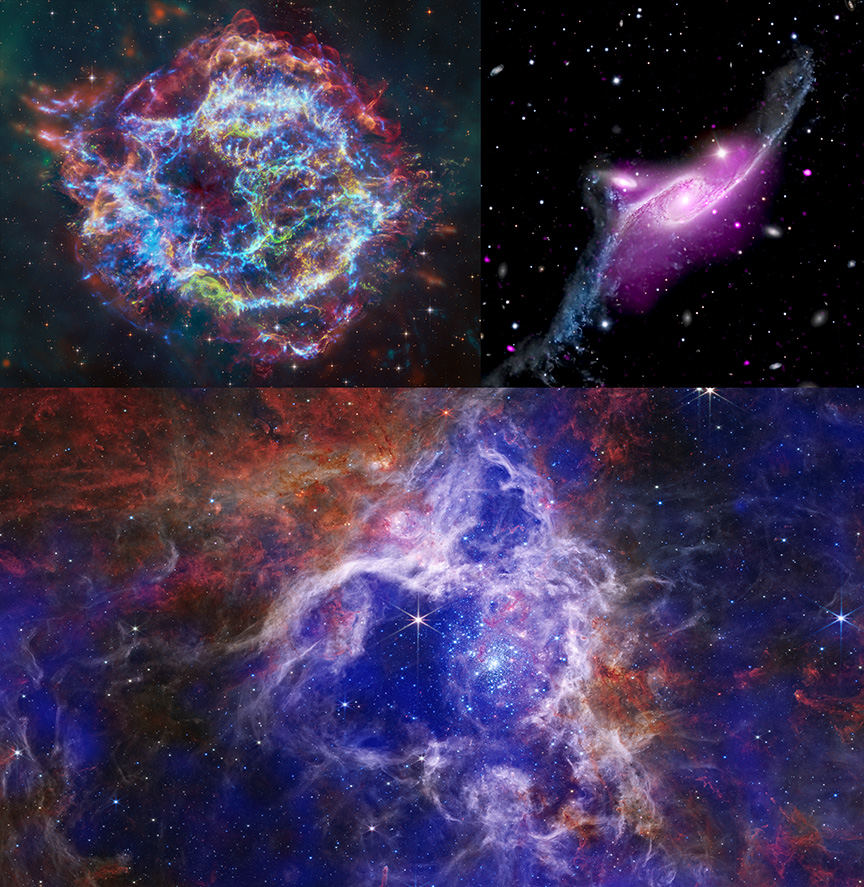
Rocket Hardware for Future Artemis Flights Moved to Barge for Delivery to Kennedy
NASA is making strides with the Artemis campaign as key components for the SLS (Space Launch System) rocket continue to make their way to NASA's Kennedy Space Center. Teams with NASA and Boeing loaded the core stage boat-tail for Artemis III and the core stage engine section for Artemis IV onto the agency's Pegasus barge at Michoud Assembly Facility on Aug. 28.

The core stage hardware joins the launch vehicle stage adapter for Artemis II, which was moved onto the barge at NASA's Marshall Space Flight Center on Aug. 21. Pegasus will ferry the multi-mission rocket hardware more than 900 miles to the Space Coast of Florida. Teams with the NASA's Exploration Ground Systems Program will prepare the launch vehicle stage adapter for Artemis II stacking operations inside the Vehicle Assembly Building, while the core stage hardware will be moved to Kennedy's Space Systems Processing Facility for outfitting. Beginning with Artemis III, core stages will undergo final assembly at Kennedy.
The launch vehicle stage adapter is essential for connecting the rocket's core stage to the upper stage. It also shields sensitive avionics and electrical components in the rocket's interim cryogenic propulsion stage from the intense vibrations and noise of launch.
The boat-tail and engine section are crucial for the rocket's functionality. The boat-tail extends from the engine section, fitting snugly to protect the rocket's engines during launch. The engine section itself houses more than 500 sensors, 18 miles of cables, and key systems for fuel management and engine control, all packed into the bottom of the towering 212-foot core stage.
NASA is working to land the first woman, first person of color, and its first international partner astronaut on the Moon under Artemis. SLS is part of NASA's backbone for deep space exploration, along with the Orion spacecraft, supporting ground systems, advanced spacesuits and rovers, the Gateway in orbit around the Moon, and commercial human landing systems. SLS is the only rocket that can send Orion, astronauts, and supplies to the Moon in a single launch.
Marshall manages the SLS Program and Michoud.
25 Years Strong: NASA's Student Launch Competition Accepting 2025 Proposals
By Wayne Smith
NASA's Student Launch competition kicks off its 25th year with the release of the 2025 handbook, detailing how teams can submit proposals by Sept. 11 for the event scheduled next spring near NASA's Marshall Space Flight Center.
Student Launch is an annual competition challenging middle school, high school, and college students to design, build, test, and launch a high-powered amateur rocket with a scientific or engineering payload. After a team is selected, they must meet documentation milestones and undergo detailed reviews throughout the school year.

Each year, NASA updates the university payload challenge to reflect current scientific and exploration missions. For the 2025 season, the payload challenge will again take inspiration from the Artemis missions, which seek to land the first woman and first person of color on the Moon.
As Student Launch celebrates its 25th anniversary, the payload challenge will include "reports" from STEMnauts, non-living objects representing astronauts. The 2024 challenge tasked teams with safely deploying a lander mid-air for a group of four STEMnauts using metrics to support a survivable landing. The lander had to be deployed without a parachute and had a minimum weight limit of five pounds.
"This year, we're shifting the focus to communications for the payload challenge," said John Eckhart, technical coordinator for Student Launch at Marshall. "The STEMnaut 'crew' must relay real-time data to the student team's mission control. This helps connect Student Launch with the Artemis missions when NASA lands astronauts on the Moon."
Thousands of students participated in the 2024 Student Launch competition - making up 70 teams representing 24 states and Puerto Rico. Teams launched their rockets to an altitude between 4,000 and 6,000 feet, while attempting to make a successful landing and executing the payload mission. The University of Notre Dame was the overall winner of the 2024 event, which culminated with a launch day open to the public.
Student Launch began in 2000 when former Marshall Director Art Stephenson started a student rocket competition at the center. It started with just two universities in Huntsville competing - Alabama A&M University and the University of Alabama in Huntsville - but has continued to soar. Since its inception, thousands of students have participated in the agency's STEM competition, with many going on to a career with NASA.
"This remarkable journey, spanning a quarter of a century, has been a testament to the dedication, ingenuity, and passion of countless students, educators, and mentors who have contributed to the program's success," Eckhart said. "NASA Student Launch has been at the forefront of experiential education, providing students from middle school through university with unparalleled opportunities to engage in real-world engineering and scientific research. The program's core mission - to inspire and cultivate the next generation of aerospace professionals and space explorers - has not only been met but exceeded in ways we could have only dreamed of."
To encourage students to pursue degrees and careers in STEM (science, technology, engineering, and math), Marshall's Office of STEM Engagement hosts Student Launch, providing them with real-world experiences. Student Launch is one of NASA's nine Artemis Student Challenges - a variety of activities that expose students to the knowledge and technology required to achieve the goals of Artemis.
In addition to the NASA Office of STEM Engagement's Next Generation STEM project, NASA Space Operations Mission Directorate, Northrup Grumman, National Space Club Huntsville, American Institute of Aeronautics and Astronautics, National Association of Rocketry, Relativity Space and Bastion Technologies provide funding and leadership for the competition.
"These bright students rise to a nine-month challenge for Student Launch that tests their skills in engineering, design, and teamwork," said Kevin McGhaw, director of NASA's Office of STEM Engagement Southeast Region. "They are the Artemis Generation, the future scientists, engineers, and innovators who will lead us into the future of space exploration."
Smith, a Media Fusion employee and the Marshall Star editor, supports the Marshall Office of Communications.
NASA Expands Human Exploration Rover Challenge to Middle Schools
By Wayne Smith
Following a 2024 competition that garnered international attention, NASA is expanding its Human Exploration Rover Challenge (HERC) to include a remote control division and inviting middle school students to participate.
The 31st annual competition is scheduled for April 11-12, 2025, at the U.S. Space & Rocket Center, near NASA's Marshall Space Flight Center. HERC is managed by NASA's Southeast Regional Office of STEM Engagement at Marshall. The HERC 2025 Handbook has been released, with guidelines for the new remote control (RC) division - ROVR (Remote-Operated Vehicular Research) - and detailing updates for the human-powered division.

"Our RC division significantly lowers the barrier to entry for schools who don't have access to manufacturing facilities, have less funding, or who are motivated to compete but don't have the technical mentorship required to design and manufacture a safe human-powered rover," said Chris Joren, HERC technical coordinator. "We are also opening up HERC to middle school students for the first time. The RC division is inherently safer and less physically intensive, so we invite middle school teams and organizations to submit a proposal to be a part of HERC 2025."
Another change for 2025 is the removal of task sites on the course for the human-powered rover division, allowing teams to focus on their rover's design. Recognized as NASA's leading international student challenge, the 2025 challenge aims to put competitors in the mindset of the Artemis campaign as they pitch an engineering design for a lunar terrain vehicle - they are astronauts piloting a vehicle, exploring the lunar surface while overcoming various obstacles.
"The HERC team wanted to put together a challenge that allows students to gain 21st century skills, workforce readiness skills, and skills that are transferable," said Vemitra Alexander, HERC activity lead. "The students have opportunities to learn and apply the engineering design process model, gain public speaking skills, participate in community outreach, and learn the art of collaborating with their peers. I am very excited about HERC's growth and the impact it has on the students we serve nationally and internationally."
Students interested in designing, developing, building, and testing rovers for Moon and Mars exploration are invited to submit their proposals to NASA through Sept. 19.
More than 1,000 students with 72 teams from around the world participated in the 2024 challenge as HERC celebrated its 30th anniversary as a NASA competition. Participating teams represented 42 colleges and universities and 30 high schools from 24 states, the District of Columbia, Puerto Rico, and 13 other nations from around the world.
"We saw a massive jump in recognition, not only from within the agency as NASA Chief Technologist A.C. Charania attended the event, but with several of our international teams meeting dignitaries and ambassadors from their home countries to cheer them on," Joren said. "The most impressive thing will always be the dedication and resilience of the students and their mentors. No matter what gets thrown at these students, they still roll up to the start line singing songs and waving flags."
HERC is one of NASA's eight Artemis Student Challenges reflecting the goals of the Artemis campaign, which seeks to land the first woman and first person of color on the Moon while establishing a long-term presence for science and exploration. NASA uses such challenges to encourage students to pursue degrees and careers in the STEM fields of science, technology, engineering, and mathematics.
Since its inception in 1994, more than 15,000 students have participated in HERC - with many former students now working at NASA, or within the aerospace industry.
Smith, a Media Fusion employee and the Marshall Star editor, supports the Marshall Office of Communications.
New NASA Sonifications Listen to the Universe's Past
A quarter of a century ago, NASA released the "first light" images from the agency's Chandra X-ray Observatory. This introduction to the world of Chandra's high-resolution X-ray imaging capabilities included an unprecedented view of Cassiopeia A, the remains of an exploded star located about 11,000 light-years from Earth. Over the years, Chandra's views of Cassiopeia A have become some of the telescope's best-known images.
To mark the anniversary of this milestone, new sonifications of three images - including Cassiopeia A (Cas A) - are being released. Sonification is a process that translates astronomical data into sound, similar to how digital data are more routinely turned into images. This translation process preserves the science of the data from its original digital state but provides an alternative pathway to experiencing the data.

This sonification of Cas A features data from Chandra as well as NASA's James Webb, Hubble, and retired Spitzer space telescopes. The scan starts at the neutron star at the center of the remnant, marked by a triangle sound, and moves outward. Astronomers first saw this neutron star when Chandra's inaugural observations were released 25 years ago this week. Chandra's X-rays also reveal debris from the exploded star that is expanding outward into space. The brighter parts of the image are conveyed through louder volume and higher pitched sounds. X-ray data from Chandra are mapped to modified piano sounds, while infrared data from Webb and Spitzer, which detect warmed dust embedded in the hot gas, have been assigned to various string and brass instruments. Stars that Hubble detects are played with crotales, or small cymbals.
Another new sonification features the spectacular cosmic vista of 30 Doradus, one of the largest and brightest regions of star formation close to the Milky Way. This sonification again combines X-rays from Chandra with infrared data from Webb. As the scan moves from left to right across the image, the volume heard again corresponds to the brightness seen. Light toward the top of the image is mapped to higher pitched notes. X-rays from Chandra, which reveal gas that has been superheated by shock waves generated by the winds from massive stars, are heard as airy synthesizer sounds. Meanwhile, Webb's infrared data show cooler gas that provides the raw ingredients for future stars. These data are mapped to a range of sounds including soft, low musical pitches (red regions), a wind-like sound (white regions), piano-like synthesizer notes indicating very bright stars, and a rain-stick sound for stars in a central cluster.
The final member of this new sonification triumvirate is NGC 6872, a large spiral galaxy that has two elongated arms stretching to the upper right and lower left, which is seen in an optical light view from Hubble. Just to the upper left of NGC 6872 appears another smaller spiral galaxy. These two galaxies, each of which likely has a supermassive black hole at the center, are being drawn toward one another. As the scan sweeps clockwise from 12 o'clock, the brightness controls the volume and light farther from the center of the image is mapped to higher-pitched notes. Chandra's X-rays, represented in sound by a wind-like sound, show multimillion-degree gas that permeates the galaxies. Compact X-ray sources from background galaxies create bird-like chirps. In the Hubble data, the core of NGC 6872 is heard as a dark low drone, and the blue spiral arms (indicating active star formation) are audible as brighter, more highly pitched tones. The background galaxies are played as a soft pluck sound while the bright foreground star is accompanied by a crash cymbal.






